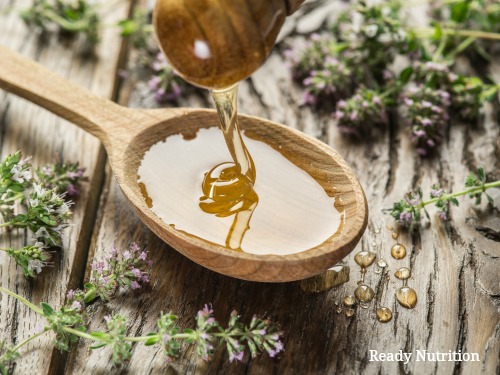
Years ago, the Mrs. and I made a major move. We had a specific timetable to adhere to, and as we were moving ourselves, efficiency was the word that exemplified our overall goals. About an hour before we were going to batten down the hatches and hit the road, she slipped and slammed her shin on the edge of the moving van’s bumper: a combination of a laceration and abrasion, as well as potential for a broken bone.
What to do on something such as this? Well, we certainly had enough antibiotics and (if it was broken) the hospital was close by. She/we decided on some ice, a bandage, and (so as not to go into our antibiotics) herbal aids. Oregano is one of the best herbs to have on hand for natural medicine and an astringent can be made from oregano tincture to wipe down the abrasion.
Oregano Tincture
- Add handfuls of oregano flower and leaves to a pint-size jar until 3/4 full and cover them with 80-proof alcohol, such as vodka.
- Allow the jar to sit for 3-6 weeks out of sunlight.
- Strain the mixture and transfer to a tincture bottle, or proceed to make a double-strength infusion.
For oral dosage: The standard adult dose is 1/2 to 1 teaspoon up to three times a day, as needed. Children usually get 1/4 to 1/3 of the adult dose.
To make astringent: Add 1 tablespoon oregano tincture to 1 cup of distilled water.
Learn more ways to disinfect wounds using pantry staples
Wound Care Made with Sugar and Honey
Once we applied the astringent to the wound, we made up a sugar formula that was common during the Napoleonic era:
- 1 tablespoon sugar
- 1/2 teaspoon of honey
Mix sugar and honey together and pack the laceration with it, spreading it liberally upon the abrasion and dressing it.
Monitor and change dressing daily.
Why Sugar and Honey Is Great For Natural Wound Care
We’re talking about plain white sugar, here: the same kind vilified for the diet is actually very beneficial with regard to wound therapy. The sugar promotes tissue repair, while fostering an antimicrobial, anaerobic environment regarding the wound. The sugar can be mixed with honey or glycerin (honey is cheaper and easier to get a hold of). On some kind of laceration, you can pack it with the mixture after cleaning out the laceration with clean water and/or a mild astringent (such as the one I first mentioned).
The dressing needs to be changed once every day, and the packed laceration monitored for signs of swelling and tenderness. Also, put fresh mixture to cover the overall wound, and then redress it with a fresh dressing and bandage. The sugar will also reduce the amount of scarring and enable the wound to heal at a faster rate.
Sugar can also be used as an Oral Rehydration Solution (ORS), in combination with table salt. Take a one-quart bottle (remember how I advised to save those empty Gatorade and Power-Ade bottles, the 32-ouncers? This is why.), and fill it up with water, leaving a little space. Put ½ cup of your sugar into it, and about ½ tsp of salt. Voila! You have effectively made your own field-expedient “Gatorade,” minus the potassium. The reason this is good is that the sugar will provide quick sugar to the bloodstream, while the salt will help to replace what you have either lost from sweating or from trauma.
Your sugars and honeys (yes, honey is a form of sugar) can be used to sweeten up a tincture that you might have to take in water. If you have ever had Lomatium (Lomatium dissectum), it is one of the worst-tasting substances you can imagine. We adults can grin and bear it, but when you’re administering a tincture to a kid, it is a big help to make it taste not quite so bad.
Honey For Wound Care
Honey is also good for wounds/abrasions/cuts of the mouth, as it is a demulcent that soothes abraded tissues, and it also is a medium that microbes do not live in. Who doesn’t remember the time-honored honey and lemon mixture for a sore throat? The thing of it is: it works, and if it works it should be employed. For the wound-packing mixture I advised above? Honey is the medium that keeps the sugar from falling out of the wound and congeals it to keep the dressing viable longer.
The reason these should be kept in mind: when the SHTF they are easily found. You’re much more likely to find either of these two (sugar and/or honey) in a gas station or convenience store out in the middle of nowhere than a Cephalosporin such as Keflex (Cephalexin, if you prefer) for a soft tissue injury. That’s what this is all about: winning with the weapons you have and tailor-making things you can rely on. Practice with them sometime for something minor. You’ll see results and build confidence in what you do. That’s the way! JJ out!
